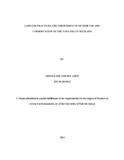| dc.description.abstract | Globally, wetlands are under serious threat from the continuous reclamation due to demand to
satisfy human development needs. Wetlands are the worlds’ most productive environment and
rich in biological diversity of plants and animals. Wetlands provide many ecosystem services to
humans and the environment ranging from fresh water, food, regulation of climate, coastal
protection, regulation of floods, tourism and recreational activities, and water purification.
Despite the mounting recognition of the need to protect wetlands, many continue to be
overexploited sometimes resulting to their total loss.
Wetland ecosystems in Kenya similarly face serious threats of degradation. This is mainly
caused by conversion of wetlands for agriculture and industrial use and high population directly
dependent on natural resources coupled with poor wetlands regulation. The situation is also
worsened by lack of funding and the active participation of the people in the controlling of the
various resources in the wetland regions, unplanned developments in wetland areas, and lack of a
working National Wetlands Policy and crosscutting sectoral laws.
The Tana River Delta is among the most important wetlands in Kenya listed as a Wetland of
International Importance under the Ramsar Convention; however, various land uses, either
proposed or ongoing are not consistent with the wise use and conservation of the wetland
ecosystem. Large-scale commercial land uses remain the biggest threat to the Tana River Delta
wetland.
The purpose of the research was to study the environmental impact of land utilization practices
in the Tana Delta wetland, assess the compatibility of the land uses with the principal of wise
use, and recommend necessary mitigation measures.
The study was conducted in villages of Kulesa, Wema, and Hewani in Minjila area of Garsen in
the Tana Delta. The local leaders totaling 23 and 9 key informants were selected through the
purposive sampling method. Data was gathered from the local leaders and the key informants
through focus group discussion and in-depth interviews respectively.
The findings of the study are that: the land use in the Tana Delta is not consistent with wise use
and sustainable utilization of the Tana Delta resources. Some of the land uses include conversion
of large tracks of land for rice irrigation, diversion of the river through a canal from Kitere area
to a rubber dam at Sailoni, the creation of 43-kilometer long dyke affecting the hydrological
cycle of the flood plain. It has also led to the involuntary displacement of people, loss of habitat
for water birds and wildlife, over abstraction of water, and conflicts over resources. | en_US |



